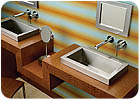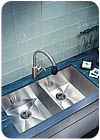It doesn't seem that many years ago that we viewed stainless steel as a material suited for making sinks and toasters - and that was about it. For use beyond that, whether for other applications in the kitchen or anywhere else in the house, it was generally considered too cold and institutional looking.

It doesn't seem that many years ago that we viewed stainless steel as a material suited for making sinks and toasters - and that was about it. For use beyond that, whether for other applications in the kitchen or anywhere else in the house, it was generally considered too cold and institutional looking.
Fast forward to today, and it's clear that we've gone through a change in religion. In the kitchen alone, we now see stainless being used for almost every conceivable component. What influences were responsible for this current acceptance of the metal look? A key seminal one was introduction of the commercial look into residential kitchens. Once the Viking genre of stove found its place in the home, it logically followed that other appliances with stainless steel fronts would make sense. The marketing muscle of appliance manufacturers then exposed stainless for the kitchen like never before, and it wasn't long before the concept reached a “quantum mass” of consumer acceptance. After that, the momentum was unstoppable, carrying over to just about every other component in the kitchen.
Look at the examples we have now:
- Appliances
- Counters
- Wall and ceiling tiles
- Cabinets
- Tables, chairs & bar stools
- Range hoods
- Faucets
- Accessory systems: Ceiling-hung or rail
- Sinks: A new generation with exposed fronts
Accessories
Let's take a closer look at some key plumbing pieces of this story. It's important to understand that the increased use of stainless steel isn't just a matter of taking designs previously made in other materials and converting them - the designs themselves are significantly new in many cases.
Faucets
When it comes to faucet construction, stainless steel is a term that is used with a wide range of definitions today. There are three common ones to be aware of:- Electro-plated brushed nickel (sometimes called satin nickel)
This is a plated finish applied to brass faucets that gives them a “stainless look.” Though the faucets are not actually made of stainless steel, the nickel color and brushed surface often marry well with stainless sinks. (Be aware that there are variations in color and texture from one brand to another.) - Stainless-clad hybrids
There are also faucets that are given a thin stainless steel “skin” assembled over a brass body. These typically are furnished with all-stainless spouts. - Solid stainless steel
Like the name says, the faucet body of this type is stainless steel clear through. Unlike the options above, water is not exposed to brass waterways, assuring zero lead exposure. Solid stainless faucets are most often constructed by fabricating machined parts together (as opposed to the use of castings). This is a somewhat limiting design factor, but ties in well with the current popularity of minimalist styling (using basic cylindrical forms).

Sinks
To some extent, there is a little less stainless steel visible on one popular type of sink installation - the undermount variety that eliminates the traditional faucet deck and rim. But there is another trend that is exposing more of the material - farmhouse and other styles that project forward beyond the cabinet and counter to reveal a front apron. The popularity of these large capacity sinks has also influenced a trend toward sharper corners in the bowls of sink models overall, including undermount and drop-in types. This is a distinct reversal of a long-standing norm in sink design in which corners are well-rounded. Manufacturers call this new approach “zero radius.” The sharp corners are made possible by the construction method used, called fabrication. Unlike conventional stainless steel sink manufacturing based on drawing the compartments or complete sinks from sheets of stainless material, fabrication involves the welding of pieces together. The joints are then concealed through grinding and polishing operations. (The result is impressive, but expensive, since there is much more hand work involved.) We are also seeing more variety in the finish of stainless steel sinks, with examples that include embossing, texturing and even basket-weave fronts.
Lavatories
This is a category that has seen the most creative design input of all residential plumbing fixtures in recent years, and while stainless steel has played a part so far, I suspect the most significant impact is just beginning. We are starting to see a carryover of the fabricated approach used on kitchen sinks, giving us a fresh new wave of design options for the bath. In addition to double-wall vessel types that have been around for a while, we are now seeing a generation of angular designs in undermount, drop-in and integral-with-top forms (the latter providing a stainless steel verneer over a wood vanity top). Following the lead of some European manufacturers, we are also seeing some creative drain options, such as the “slit” and “trench” types located at the rear of the basin.Stainless toilets, tubs and other things you loved about your jail cell
Okay, they're not really prison fixtures, but the construction is similar (and whoda thunk we'd be seeing things like this coming into the home?) Give this some thought as a nice way to make Uncle Harry feel at home next time he gets out on parole.Footnotes: Unlike some trends of the past, stainless steel has merit both in form and function. In other words, not only do people like the way it looks, it has excellent performance characteristics, as well. When it comes to the durability of a plumbing product, it doesn't get any better. Contrast that with the craziness that hit the faucet business about 20 years ago with the introduction of countless finish options. We made the mistake of getting consumers excited over them, only to find that making them so they would last turned into our worst nightmares in many cases (granted, better finishing technologies evolved with time). Somehow, I suspect we'll see stainless steel around a lot longer than we saw powder coated dusty pink. The lack of finish options is one of the things that manufacturers and those involved in the distribution of stainless steel products like most about them. Except for choices between brushed and mirror finishes in some cases, they come in just one flavor. So it's real simple - stainless comes in stainless. Don't you wish the rest of your business was like that?
